Allan Rosen's comments appeared in the Queens Chronicle newspaper and is a member of QPTC. The title speaks for itself. The item below represents the position of QPTC and was developed within the group.
Ten myths about select and rapid-transit buses
by Allan Rosen, | Posted: Thursday, April 16, 2015 10:30 am
Let’s examine things we’re being told about Select Bus Service and Bus Rapid Transit that aren’t true.
1. SBS/BRT is the best cost-effective solution to improve north-south travel in the Woodhaven-Cross Bay Boulevard corridor.
Actually,
restoring the abandoned Rockaway Beach Line offers more advantages. It
provides faster trips without removing two needed general traffic lanes.
Studies have shown the public prefers rail to bus. Rail will stimulate
development. The RBL is also greener and quieter because it uses
electric power. It won’t impede first responders, unlike the design the
city Department of Transportation has chosen.
The DOT cannot
be trusted to provide truthful figures. It had been touting $28 million
for SBS, then it suddenly escalated the cost to $200 million with BRT.
That cost could double if any of the work has to be redone such as
switching to Option 1 midstream, because emergency response times
increase. Pedestrian islands may have to be ripped out, as happened
several years ago in front of Maimonides Hospital in Brooklyn, when
these islands were installed without discussions with EMS personnel.
There
also are plans to destroy the RBL with the QueensWay trail, which has
been priced at $120 million, and would likely escalate. The combined BRT
and Queens-Way costs approach the cost of restoring the RBL, which
provides a far superior level of service. Regulatory flexibility to
permit shared LIRR/subway operations or an LIRR/subway transfer at
Aqueduct or Howard Beach eliminates the cost of a new bridge across
Jamaica Bay.
2. SBS/BRT will encourage drivers to switch to buses.
The
number of transfers and fares needed to make a trip will not be
reduced, a major reason why many choose to drive. Therefore motorists
will not switch modes to compensate for the loss of general traffic
lanes.
3. SBS increases bus reliability.
SBS buses
operate no more reliably than local bus routes. SBS buses frequently
arrive in bunches along Second Avenue in Manhattan and along Nostrand
Avenue in Brooklyn. Many passengers see no improvement over the former
Limited service SBS replaced.
4. Buses traveling faster equates with faster trip times for bus passengers.
Actually,
for someone to fully benefit from bus travel time savings, they must
ride from the first stop until the last stop, which few passengers do.
There will be no savings for the passenger of up to 35 percent as DOT’s
press release claims.
5. Bus passengers will save time during the off-peak.
During
the midday before 3 p.m., in the evening and on weekends, buses already
travel the maximum allowable speed and would not travel any faster
because of exclusive bus lanes.
6. The needs of automobile drivers will be met.
Only
the needs of bus riders have been considered, though they account for
only one-third of the road’s users. The DOT admits that the majority —
57 percent — of Woodhaven Corridor residents own cars, though they state
the negative that 43 percent of the households do not own cars.
The
DOT also plans to ban left turns at Metropolitan Avenue and Rockaway
Blvd. It claims that this won’t negatively impact drivers, but that is
wrong. Drivers will have to travel farther and be forced to first travel
in the opposite direction of where they want to go.
7. Traffic will improve after BRT is completed.
Traffic
will significantly worsen with two lanes for general travel removed,
and mergers from four lanes to three will become mergers of three lanes
to two. The net result is increased congestion for motorists and also
commercial vehicles as there is no nearby alternative north-south route.
That includes livery cabs that transit-dependent residents rely on for
doctor’s appointments and shopping,
8. Three lanes for general traffic will be maintained throughout the corridor.
Although
this is what the DOT had promised throughout the process, only two
lanes for general traffic will be maintained where Woodhaven passes
beneath and above the LIRR, and a two-lane option is being considered
for Cross Bay Boulevard as well.
9. Construction will be completed within a year.
None
of the DOT’s past time estimates has been accurate. Even the first-year
assessment for the B44 SBS is over four months late.
10. Community involvement has been adequate throughout.
Questions
asked one year ago still have not been responded to, and there has been
no outreach specifically for automobile drivers, who are mostly unaware
of the BRT plans, which will greatly affect them. SBS was a
predetermined conclusion before the first public meeting.

